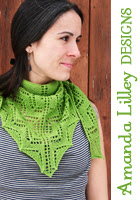Once a week I post interviews with interesting designers about their insights on their experience of working in the Knitting industry. I’ve noticed that every designer makes their living in a slightly different manner bringing their own unique presence to the Knitting world.
You can find Tabetha here and here on Ravelry.
 |
| Pattern available here. |
Where do you find inspiration?
I am often surprised at how and when inspiration hits me, but it comes from a variety of sources: stitch pattern books, fashion shows, magazines, art, nature, and, yes, even my own knitting mistakes.
What is your favourite knitting technique?
I don’t have a particularly favorite technique, but I will say that I love swatching and I love seaming. I know, I know – I am the anomaly in that respect.
How did you determine your size range?
When self-publishing, I want to make my designs available to as many sizes possible, so I spend a lot of time graphing and grading to ensure that range.
Do you look at other designers’ work or are you afraid that you will be influenced by their designs?
When I first began designing, I was afraid of looking at other designers’ work. As I have grown, however, and developed my own “style,” so to speak, I browse other designs to notice trends, learn what to avoid, and celebrate their new innovations.
 |
| Pattern available here. |
How do you feel about the so called controversy of “dumbing down” patterns for knitters?
I’ve heard the term, but am not familiar with the debates. For myself, I focus on providing patterns that are clear, well-written, and provide enough of a challenge to encourage the knitter to grow in their skills.
How many sample/test knitters do you have working for you or do you do it all yourself?
At the moment, I do it all myself. I do have 1 back-up knitter, just in case.
Did you do a formal business plan?
Yes, I have a business plan, but I wouldn’t call it formal. It’s more of a journal filled with submission locations, indie ideas, marketing thoughts, and where I want to be in 5 years.
Do you have a mentor?
Yes! Jill Wright (http://www.woolcrafting.com/)
 |
| Pattern available here. |
Do you have a business model that you have emulated?
No, but I think I have read every single business, marketing, budgeting, pr, and consulting book in the library system.
What impact has the Internet had on your business?
I would imagine that my business would be MUCH more difficult without the web. I spend hours researching fashion trends, textiles, and knitting markets online. Advertising, online submissions, and magazine inquiries would be significantly more expensive and harder.
Do you use a Tech Editor?
Absolutely!! I mostly rely on Ashley Knowlton, who is thorough, concise, and fast. I do not believe that you can develop a good brand without a good tech editor.
 |
| Pattern available here. |
How do you maintain your life/work balance?
Developing a routine with the kids (my 2 girls are 4 and 6 years old), breaking down and organizing the housekeeping/chore schedule, and having the support of an amazing husband are probably the three biggest components to making my job work. Scheduling my working “time blocks” is important (I love scheduling as much as I love organizational lists), but having the flexibility to accept that nothing is perfect (or permanent) makes it all a little easier.
How do you deal with criticism?
Criticism is hard in the “artistic” field, such as knitwear design, since complaints or disapproval can easily take on a personal note. I worry incessantly that I’ve messed up someone’s project or day because clear, quality patterns are so important to me. I immediately fix what needs to be fixed, offer amends, or try to support where I can. I have a harder time with blanket terms or general statements of displeasure, since they don’t provide a window in what to fix. Those tend to hurt, but my armor is getting thicker as time goes by.
How long did it take for you to be able to support yourself?
I’m still not able to support myself, but that’s in my 5 year plan.
What advice would you give someone who wants to pursue a career in knitting?
Have a support system, keep practicing, keep trying, and don’t give up. It is a hard, hard market to break in to, but as long as you carry yourself as a professional businesswoman (or man), you’ll find that entry way to be a little wider.
 |
| Pattern available here. |






























